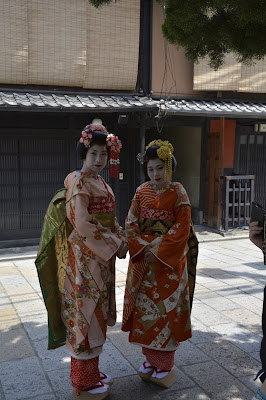We boarded Singapore Air in Amsterdam at 11am and settled in for our 12+ hours of coach travel. The airlines reputation for service and comfort was well deserved. The entertainment system came via a personal view screen in every seat with over 260 movies, television shows, documentaries and a learning channel that taught James how to count to 100 in Japanese. Between the two of us we watched 8 movies, 5 shows and James is now fluent in Swahili. The only thing that made the flight attendants stop cruising the isles was the nearly constant turbulence that keep the seat belt sign on for a total of 6 hours of the flight. It was a surprisingly easy 12 hours and 40 minutes. Singapore Air ROCKS!!!!
When we landed at 5 am, we saw a tee shirt in the airport that said Singapore was moist, hot, hotter, hottest and really expensive. It also said that the spicy crab was the national dish and eating was the national pastime. We didn't buy the shirt but it turned out to be pretty close to the truth. We walked out of the airport and were hit with 96 degrees and 100% humidity. Welcome to the Equator.
 |
| Picture of the modern skyline courtesy of Wikipedia |
We stayed near Chinatown at the Amoy Hotel which was across the street from the subway and within walking distance of many of the sites we wanted to see. There were over 100 restaurants in a 4 block radius. Singapore is an expensive city, for example a beer goes for around $14 or a mixed drink can be $20 to $30. Needless to say, James had one beer the whole time we were in town.
In the center of Chinatown is the Buddha's Tooth Relic Temple. It was built to house the tooth relic of the historical Buddha. On the day we toured it was surrounded by the Chinatown street market where everything was for sale including electronics, household goods, toys and food. The market didn't slow down the crowd coming to the temple for there was a constant flow of worshipers arriving to say a prayer or light a candle.
 |
| Buddha Tooth Relic Temple |
The first floor interior was a series of rooms set up for offerings and prayers with thousands of shrines called gau. The figures of Buddha were everywhere from the size of your hand to more than 15 feet tall.
 |
| The largest Buddha in the central room of the temple |
 |
| Individual shrines all with offerings |
 |
| James was born in the Year of the Dragon |
At the end of the Chinatown markets was what James nicknamed "Old Guy Park". There were dozens of gentleman enjoying the shade and playing Go. We figured their wives were home enjoying the air conditioning.
 |
| Nice shady spot |
|
That is a lot of air conditioners
|
 |
| Chinatown street market with the city as a backdrop |
Durian is sometimes referred to as the King of Fruit in Southeast Asia. It has a sickly sweet odor that has been described as smelling like turpentine, raw sewage, or rotten onions. It has been banned in some hotels and on the public transportation in the city. It was sold everywhere and there was even a open air restaurant serving only durian dishes. We could smell it from 20 feet away.
 |
| The "King of Fruit" |
 |
| From the subway overhead - No durians welcome! |
We noticed this gentleman and his Honda motorcycle ice cream scooter cart. Now that is a good idea.
 |
We're watching the want ads
|
Eating lunch and dinner was very expensive in a restaurant, but you could reduce your cost and get a sense of the local flavor via the takeaway food found around the city. The government has brought all the street food venders together under many large covered areas and regulates them for health and cleanliness. These Hawker Centers have some of the best food and you can get a large meal for around 6 Singapore dollars.
Singapore is a strange combination of old traditions surrounded by modern commerce. The city is looking to the future with new architecture and transportation systems. They have kept some of their history in neighborhoods like Chinatown.
Singapore is at 1.33N, 103.91E. The average high during our stay was 94 degrees with 100% humidity.
Next stop is Tokyo, Japan, but first another long flight.
Cheers,
P&J




























































